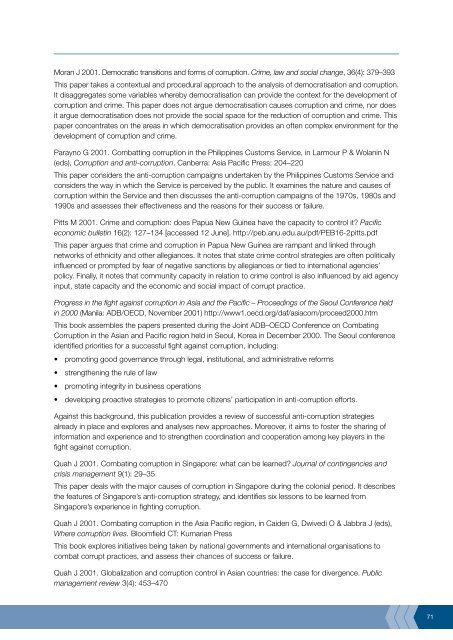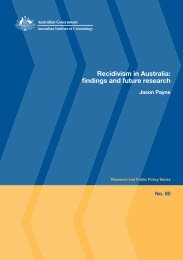Review of anti-corruption strategies Rob McCusker - Australian ...
Review of anti-corruption strategies Rob McCusker - Australian ...
Review of anti-corruption strategies Rob McCusker - Australian ...
Create successful ePaper yourself
Turn your PDF publications into a flip-book with our unique Google optimized e-Paper software.
Moran J 2001. Democratic transitions and forms <strong>of</strong> <strong>corruption</strong>. Crime, law and social change, 36(4): 379–393<br />
This paper takes a contextual and procedural approach to the analysis <strong>of</strong> democratisation and <strong>corruption</strong>.<br />
It disaggregates some variables whereby democratisation can provide the context for the development <strong>of</strong><br />
<strong>corruption</strong> and crime. This paper does not argue democratisation causes <strong>corruption</strong> and crime, nor does<br />
it argue democratisation does not provide the social space for the reduction <strong>of</strong> <strong>corruption</strong> and crime. This<br />
paper concentrates on the areas in which democratisation provides an <strong>of</strong>ten complex environment for the<br />
development <strong>of</strong> <strong>corruption</strong> and crime.<br />
Parayno G 2001. Combatting <strong>corruption</strong> in the Philippines Customs Service, in Larmour P & Wolanin N<br />
(eds), Corruption and <strong>anti</strong>-<strong>corruption</strong>. Canberra: Asia Pacific Press: 204–220<br />
This paper considers the <strong>anti</strong>-<strong>corruption</strong> campaigns undertaken by the Philippines Customs Service and<br />
considers the way in which the Service is perceived by the public. It examines the nature and causes <strong>of</strong><br />
<strong>corruption</strong> within the Service and then discusses the <strong>anti</strong>-<strong>corruption</strong> campaigns <strong>of</strong> the 1970s, 1980s and<br />
1990s and assesses their effectiveness and the reasons for their success or failure.<br />
Pitts M 2001. Crime and <strong>corruption</strong>: does Papua New Guinea have the capacity to control it? Pacific<br />
economic bulletin 16(2): 127–134 [accessed 12 June]. http://peb.anu.edu.au/pdf/PEB16-2pitts.pdf<br />
This paper argues that crime and <strong>corruption</strong> in Papua New Guinea are rampant and linked through<br />
networks <strong>of</strong> ethnicity and other allegiances. It notes that state crime control <strong>strategies</strong> are <strong>of</strong>ten politically<br />
influenced or prompted by fear <strong>of</strong> negative sanctions by allegiances or tied to international agencies’<br />
policy. Finally, it notes that community capacity in relation to crime control is also influenced by aid agency<br />
input, state capacity and the economic and social impact <strong>of</strong> corrupt practice.<br />
Progress in the fight against <strong>corruption</strong> in Asia and the Pacific – Proceedings <strong>of</strong> the Seoul Conference held<br />
in 2000 (Manila: ADB/OECD, November 2001) http://www1.oecd.org/daf/asiacom/proceed2000.htm<br />
This book assembles the papers presented during the Joint ADB–OECD Conference on Combating<br />
Corruption in the Asian and Pacific region held in Seoul, Korea in December 2000. The Seoul conference<br />
identified priorities for a successful fight against <strong>corruption</strong>, including:<br />
•<br />
•<br />
•<br />
•<br />
promoting good governance through legal, institutional, and administrative reforms<br />
strengthening the rule <strong>of</strong> law<br />
promoting integrity in business operations<br />
developing proactive <strong>strategies</strong> to promote citizens’ participation in <strong>anti</strong>-<strong>corruption</strong> efforts.<br />
Against this background, this publication provides a review <strong>of</strong> successful <strong>anti</strong>-<strong>corruption</strong> <strong>strategies</strong><br />
already in place and explores and analyses new approaches. Moreover, it aims to foster the sharing <strong>of</strong><br />
information and experience and to strengthen coordination and cooperation among key players in the<br />
fight against <strong>corruption</strong>.<br />
Quah J 2001. Combating <strong>corruption</strong> in Singapore: what can be learned? Journal <strong>of</strong> contingencies and<br />
crisis management 9(1): 29–35<br />
This paper deals with the major causes <strong>of</strong> <strong>corruption</strong> in Singapore during the colonial period. It describes<br />
the features <strong>of</strong> Singapore’s <strong>anti</strong>-<strong>corruption</strong> strategy, and identifies six lessons to be learned from<br />
Singapore’s experience in fighting <strong>corruption</strong>.<br />
Quah J 2001. Combating <strong>corruption</strong> in the Asia Pacific region, in Caiden G, Dwivedi O & Jabbra J (eds),<br />
Where <strong>corruption</strong> lives. Bloomfield CT: Kumarian Press<br />
This book explores initiatives being taken by national governments and international organisations to<br />
combat corrupt practices, and assess their chances <strong>of</strong> success or failure.<br />
Quah J 2001. Globalization and <strong>corruption</strong> control in Asian countries: the case for divergence. Public<br />
management review 3(4): 453–470















